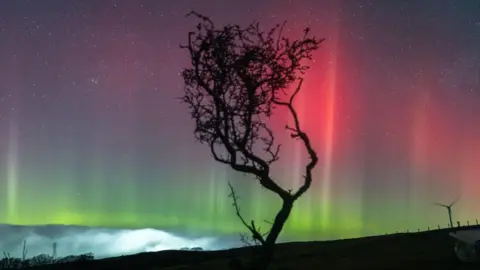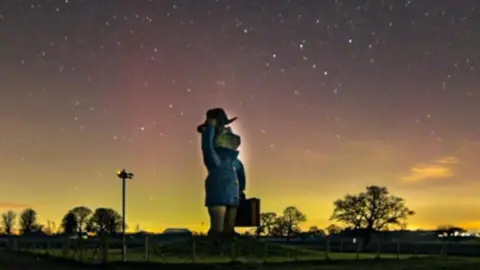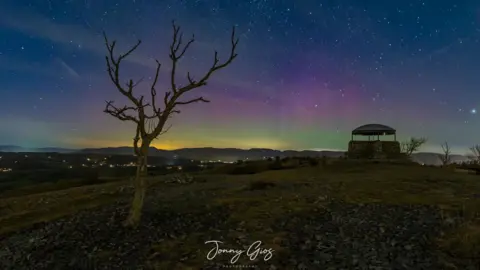Northern Lights put on show over the North-West
 Christian Spooner/BBC
Christian Spooner/BBCThe Northern Lights put on spectacular show over the North-West overnight.
Photographers from across the region captured stunning shots of the vivid greens, yellows, purples and reds of the natural phenomenon, known as Aurora Borealis.
The aurora has been more visible in recent weeks due to increased solar activity as the earth reaches the "height" of the sun's 11 year solar cycle.
Mark Griffiths, who works as a Northern Lights tour guide in Iceland during the winters, said the "main show" happened after midnight following some fainter sightings shortly after 20:00 GMT.
 Mark Griffiths
Mark Griffiths Jonny Gios
Jonny GiosMr Griffiths, 41, said he was keen to capture the lights above the Paddington Bear straw statue in Nantwich, Cheshire.
"I wanted to get that shot because the Northern Lights over Cheshire. It's not really normal is it?" he said.
"I do tours and I have seen it hundreds of times, but this was half-decent."
BBC journalist Christian Spooner captured a striking shot of the lights near Quernmore in Lancashire, while photographer Jonny Gios caught the aurora above Scout Scar in the Lake District.
Paul Byers caught vivid green and purple aurora above Maryport harbour in Cumbria, while John Griffiths managed to get footage from Ramsey in the Isle of Man.
Cameras are far more likely to be able to pick up the lights than the naked eye, but overnight there were significant periods where the colours could be seen.
According to Prof David Schultz, a professor of synoptic meteorology at the University of Manchester, there was "above average" activity last night.
AuroraWatchUK, an alert service provided by scientists in the Space and Planetary Physics group at Lancaster University's Department of Physics, recorded a period of "Amber" activity in the early hours.
Amber means the lights are likely to be visible by eye from Scotland, northern England and Northern Ireland and possibly from elsewhere in the UK.
There were also longer periods of yellow activity, meaning the lights may be visible from camera in northern England and by eye from Scotland, shortly before 21:00 and after 00:00 until shortly after 03:00.
The lights are caused when energy ejected from sun-spots in events called Coronal Mass Ejections is directed into Earth's atmosphere, where it reacts with oxygen and nitrogen.
Listen to the best of BBC Radio Lancashire on BBC Sounds and follow BBC Lancashire on Facebook, X, and Instagram and watch BBC North West Tonight on BBC iPlayer.
